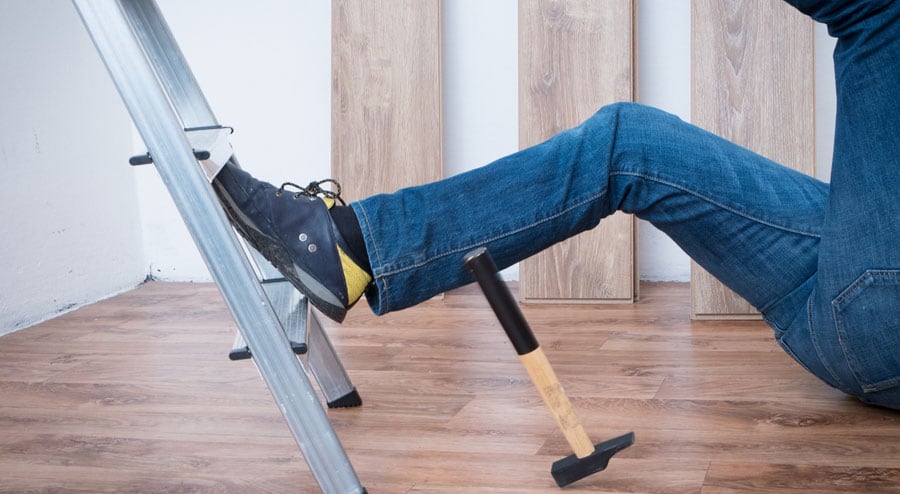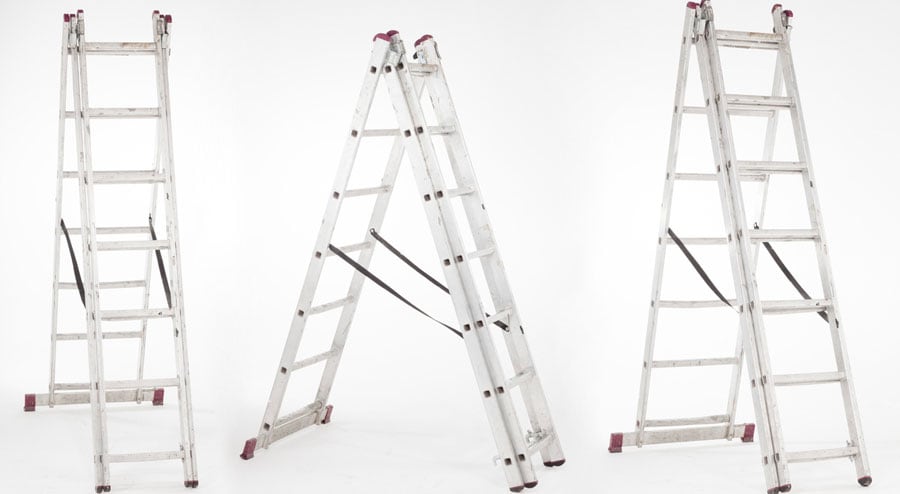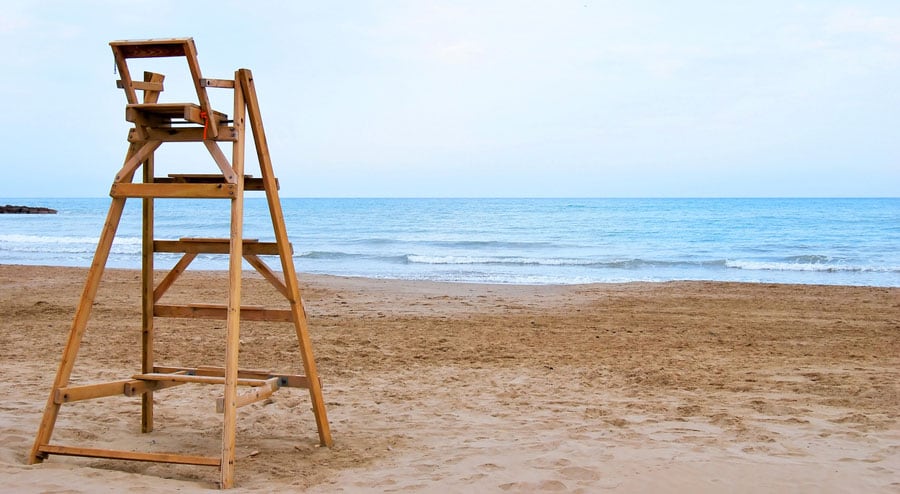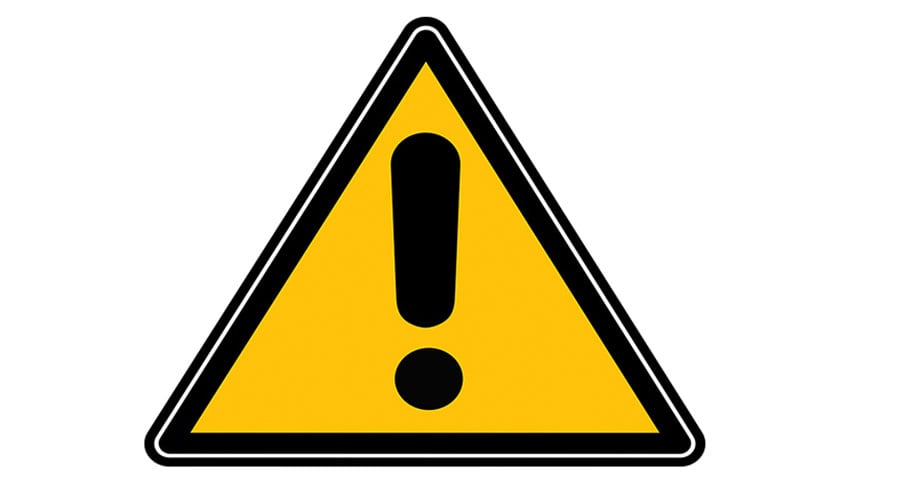As the old saying goes, it is not the falling that kills you, it’s the sudden stop. Nowhere is that truer than when climbing a ladder and even the smallest of step ladders can be fatal if not used with caution. The biggest hazard when using a ladder is that your feet will usually be firmly fixed to the device while your hands may slip, making most falls are head first and very dangerous.
Whether extension ladders, fixed ladders, portable ladders, or small wood ladders, falls from ladders of any size can create a multitude of injuries, literally from head to toe, making you lose work days, spend on medical aid or much worse. In all circumstances, it is much better to spend the extra five minutes positioning the ladder properly and making sure that it is secure than having to spend five days in a hospital for falling down from four feet.
There is also a problem when falling from relatively small heights as human psychology is gauged to embrace that fall with your hands, which is beneficial on soft ground, but is detrimental when falling on concrete, which is the material underneath most places where ladders are used. Use the ladder sensibly, stay safe and follow the manufacturer instructions and OSHA (Occupational Safety & Health Administration) recommendations and you will be able to use your ladder with little risk of fall or injury.
When Is A Ladder The Most Dangerous?

Ladders are more dangerous than power saws, nail guns, and welding tools combined. This is not because ladders themselves carry some sort of flaw that makes them inherently dangerous, but exactly the opposite. Most people are very familiar with ladders from a very young age and don’t take the necessary precautions when using them. And the lower the height the higher the risk.
People who are cleaning windows or doing maintenance at the height of several stories use all kinds of harnesses and safety equipment that will save their lives if they slip from the ladder. The problem comes at small jobs and in homes when someone is using a ladder just to clean their gutters or make small repairs that take just a couple of minutes. In those cases, people don’t think that they need to be secured which is the exact moment where disaster usually strikes.
Even when you are using the ladder for just a few minutes, have in your mind the fact that falling lasts for just a few seconds and that saving a minute for a chore or a small job is not nearly worth the injury. Before you climb up, assess if you have positioned your ladder properly, if all securities are in check, and if the ladder itself is of good quality and has no holes or damage.
If you are using wood ladders, and you see any holes or water damage, discard it immediately and use a different ladder. Although the ladder may seem like it is sturdy and only has a little water damage, it may be rotten underneath the coating and will break as soon as you apply any weight to it. Remember to never to leave your tools on top of the ladder. If you do forget that you have placed your tools there, when taking down the ladder the tools may fall down on your head and severely injure you. It is best to keep your tools in your tool belt at all times.
Positioning The ladder

The positioning of the ladder depends on the type of ladder. Once you have checked you ladder for quality, it is important to position your ladder correctly. If you are using a four-point ladder, be sure that the ladder is extended to the limit and that the holder in the middle is secured.
Never climb to the very top of the ladder and never stand on the ladder itself. If it is a small stepping ladder, always keep your top leg one level below the top, as that way you will be able to reach with your hand if you start losing balance and you will be able to secure your footing with your shin.
If you are using an extension ladder, there are a couple of things you need to look for when positioning it. If you are using the ladder on a sloping terrain, make sure the ladder is at the right angle and that the footing of the ladder is secured. Most ladders have extensions on the bottom to compensate for sloping terrain and make sure that those are firmly on the ground.
The most important thing when positioning an extension ladder is the angle you are placing it as when the angle is too steep you will become top heavy and you will be prone to fall with the ladder. If the angle is too wide there is a chance for the bottom to pop out once you are making enough top pressure, making you fall top down. Most new models have a line on the side of the ladder which will direct you to a safe angle when that line is pointing straight to the ground the ladder is safe to use.
Never lean your ladder against a gutter or a pipe, as in the best case scenario you may break the gutter or the pipe, making you do even more work, and, in the worst case scenario, the ladder may slip and you may fall. Always make sure that you are not placing the ladders on or near power lines or cables as metal ladders will conduct electricity and wooden ones will catch on fire, not to mention that you may cut the power lines, which creates all sorts of additional problems.
Testing The Ladder And Securing The Bottom
Before you even take the first step on the ladder, you must make sure that it is safe to use. Even the most rudimentary of a test may save your life and prevent you from using a faulty ladder. The first issue you need to check is the ladder footing and to make sure that it is firmly on the ground. Don’t let the ladder shake or slide on the surface and if there is no way to secure the ladder on the ground it is best to find another place from which you will be able to climb to your desired location.
Once you have secured the footing, apply strong pressure to the first few steps with your hands, making sure that the material has not deteriorated and that it is safe to climb. After this, shake the sides to see if the ladder is bent or slides in any direction. Finally, it is best to have some weight to secure the bottom of the ladder. While this may be a friend with some significant mass, it is much better to use a sandbag attached to the bottom.

Professional models have security attachments on the sides to prevent the ladder from turning or sliding, and if you are planning to use your ladder, often it may be wise to invest in such a model. There is a recommendation for you to tie the top of the ladder to a secure point, but this should be done at the end, as you need to climb the ladder first as to secure the top. Have a hook or some rope on the top as to secure the ladder quickly after climbing, making it almost impossible for it to slip or fall.
Three-Point Security And Ladder Seats
OSHA, as well as many other agencies, advises against placing both your hands off the ladder at any time. Several states even make this practice illegal, which may reduce your productivity on the ladder significantly. This is known as the ‘’three-point rule” meaning that you need to have three points of contact with the ladder at all times.

There are several ways to stay safe and inside legal boundaries when working on a ladder and this can be either using a harness attachment or having a ladder seat. A harness will be tightly secured to your waist and to the ladder, making it impossible for you to fall on your back, but this can also be dangerous as you will not be able to climb down the ladder as quickly.
Ladder seats are not common and there are not many manufacturers, but if you plan on spending a lot of time on top of your ladder, this may just be the invention that will save you a lot of time, make you a lot safer, and will provide a much more comfortable working condition, as you will be sitting instead of standing.
There Is No Such Thing As Too Much Security
It can’t be sufficiently repeated that there is no job too small for you to ensure your safety when working. It may sound like a waste of time for you to do all the things mentioned and make all the necessary precautions, but neither your work nor your family will notice the two minutes of extra time you have spent on security, and they will notice you falling and injuring yourself.
Take All The Necessary Steps, Be Safe And Work Sensibly. There Is No Job That Is As Important As Your Health And Safety.
Sources
- https://www.traceylawfirm.com/Blog/2015/April/Ladder-Safety-Tips-For-Construction-Workers.html
- https://blogs.cdc.gov/niosh-science-blog/2017/06/28/ladder-safety-wrt/
- https://onsafety.cpsc.gov/blog/2011/12/03/ladder-safety-101/
- https://www.safewise.com/blog/top-window-escape-ladders/
- https://www.thompsoncreek.com/blog/thompson-creek-windows-reviews-ladder-safety




